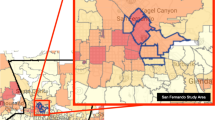Abstract
Physiologically equivalent temperature (PET) is a thermal index that is widely used in the field of human biometeorology and urban bioclimate. However, it has several limitations, including its poor ability to predict thermo-physiological parameters and its weak response to both clothing insulation and humid conditions. A modified PET (mPET) was therefore developed to address these shortcomings. To determine whether the application of mPET in hot-humid regions is more appropriate than the PET, an analysis of a thermal comfort survey database, containing 2071 questionnaires collected from participants in hot-humid Taiwan, was conducted. The results indicate that the thermal comfort range is similar (26–30 °C) when the mPET and PET are applied as thermal indices to the database. The sensitivity test for vapor pressure and clothing insulation also show that the mPET responds well to the behavior and perceptions of local people in a subtropical climate.


Similar content being viewed by others
References
Chen Y-C, Matzarakis A (2017) Modified physiologically equivalent temperature—basics and applications for western European climate. Theor Appl Climatol. https://doi.org/10.1007/s00704-017-2158-x
Chen YC (2016) Modification and adjustment of physiologically equivalent temperature for universal applications. PhD Thesis, Albert-Ludwigs-Universität Freiburg im Breisgau
Cohen P, Potchter O, Matzarakis A (2013) Human thermal perception of Coastal Mediterranean outdoor urban environments. Appl Geogr 37:1–10
de Dear RJ, Fountain ME (1994) Field experiments on occupant comfort and office thermal environments in a hot-humid climate. ASHRAE Trans 100:457–474
Fanger PO (1972) Thermal comfort. McGraw Hill, New York
Höppe P (1999) The physiological equivalent temperature—a universal index for the biometeorological assessment of the thermal environment. Int J Biometeorol 43:71–75
Kántor N, Unger J (2011) The most problematic variable in the course of human-biometeorological comfort assessment—the mean radiant temperature. centeurjgeo 3:90–100
Lin T-P, Yang S-R, Matzarakis A (2015) Customized rating assessment of climate suitability (CRACS): climate satisfaction evaluation based on subjective perception. Int J Biometeorol 59:1825–1837
Lin TP (2009) Thermal perception, adaptation and attendance in a public square in hot and humid regions. Build Environ 44:2017–2026
Lin TP, Matzarakis A (2008) Tourism climate and thermal comfort in Sun Moon Lake, Taiwan. Int J Biometeorol 52:281–290
Mahmoud AHA (2011) Analysis of the microclimatic and human comfort conditions in an urban park in hot and arid regions. Build Environ 46:2641–2656
Oliveira S, Andrade H (2007) An initial assessment of the bioclimatic comfort in an outdoor public space in Lisbon. Int J Biometeorol 52:69–84
Salata F, Golasi I, de Lieto Vollaro R, de Lieto Vollaro A (2016) Outdoor thermal comfort in the Mediterranean area. A transversal study in Rome, Italy. Build Environ 96:46–61
VDI (1998) Methods for the human biometeorological evaluation of climate and air quality for the urban and regional planning. Part I: Climate. VDI guideline 3787. Part 2. Beuth, Berlin
Yahia MW, Johansson E (2013) Evaluating the behaviour of different thermal indices by investigating various outdoor urban environments in the hot dry city of Damascus, Syria. Int J Biometeorol 57:615–630
Zeng Y, Dong L (2015) Thermal human biometeorological conditions and subjective thermal sensation in pedestrian streets in Chengdu, China. Int J Biometeorol 59:99–108
Author information
Authors and Affiliations
Corresponding author
Rights and permissions
About this article
Cite this article
Lin, TP., Yang, SR., Chen, YC. et al. The potential of a modified physiologically equivalent temperature (mPET) based on local thermal comfort perception in hot and humid regions. Theor Appl Climatol 135, 873–876 (2019). https://doi.org/10.1007/s00704-018-2419-3
Received:
Accepted:
Published:
Issue Date:
DOI: https://doi.org/10.1007/s00704-018-2419-3




